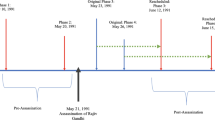Abstract
People vote although their marginal gain from voting is zero.We contribute to the resolution of this paradox by presentinga model for equilibrium configuration of attitudes regardingthe decision to vote. Each individual is seen as an element ofa social network, within which pairs of individuals expressideas and attitudes, exerting mutual influence. We model therole of such networks in propagating the mutual influenceacross pairs of individuals. We show that it may suffice thata small set of individuals have a strong feeling about showingup to vote to generate a significant turnout in elections.
Similar content being viewed by others
References
Akerlof, G. (1980). A theory of social custom, of which unemployment may be one consequence. The Quarterly Journal of Economics 94: 749–775.
Aldrich, J. (1993). Rational vote and turnout. American Journal of Political Science 37: 246–278.
Aldrich, J. (1997). When is it rational to vote? In D. Mueller (Ed.), Perspectives on public choice: A handbook, 373–390. Cambridge: Cambridge University Press.
Ashenfelter, O. and Kelley, S., Jr. (1975). Determinants of participation in Presidential elections. Journal of Law and Economics 18: 695–733.
Blume, L. and Durlauf, S. (2002). Equilibrium concepts for social interaction models. Working Paper, Department of Economics, University of Wisconsin.
Brock, W. and Durlauf, S. (2001). Discrete choice with social interactions. Review of Economic Studies 68: 235–260.
Brody, R. and Page, B. (1973). Indifference, alienation and rational decisions: The effects of candidate evaluation on turnout and the vote. Public Choice 15: 1–17.
Castanheira, M. (1999). Should I stay or should I go?: Poisson games and the paradox of voting. Mimeo. IGIER.
Coate, S. and Conlin, M. (2002). Voter turnout: Theory and evidence from Texas liquor referenda. NBER Working Paper 8720. (www.nber.org/papers/w8720).
Downs, A. (1957). An economic theory of democracy. NewYork: Harper & Row.
Durlauf, S. (1997). Statistical mechanics approaches to socioeconomic behaviour. In A.B. Arthus, S. Durlauf and D. Lane (Eds.), The economy as an evolving complex system II, 81–104. Reading, MA: Addison-Wesley.
Durlauf, S. (1999). How can statistical mechanics contribute to the study of social sciences? Proceedings of the National Academy of Science 96: 10582–10584.
Fain, J. and Dworkin, J.B. (1993).Determinants of voter participation: Some simulation results. Public Choice 77: 823–834.
Feddersen, T. and Pesendorfer, W. (1996). The swing voter curse. American Economic Review 86: 408–424.
Feddersen, T. and Sandroni, P. (2001). A theory of participation in elections. Mimeo. University of Rochester.
Frey, B. (1971). Why do high-income people participate more in politics? Public Choice 11: 10–15.
Galam, S. and Moscovici, S. (1991). Towards a theory of collective phenomena: Consensus and attitude changes in group. European Journal of Social Psychology 21: 481–495.
Goodin, R.E. and Roberts, K. (1975). The ethical vote. American Political Science Review 69: 926–928.
Guttman, J., Hilger, N. and Schachmurove, Y. (1994). Voting as investment vs. voting as consumption: New evidence. Kyklos 47: 197–207.
Harbaugh, W. (1996). If people vote because they like to, then why so many of them lie? Public Choice 89: 63–76.
Ianni, A. and Corradi, V. (2000). Consensus, contagion and clustering in a space-time model of public opinion formation. Mimeo. University of Southampton.
Ioannides, Y. (2001). Topologies of social interactions. Discussion Paper Series, Department of Economica, Tufts University, Working Paper 0104.
Keynes, J.M. (1934). The general theory of employment, interest and money. NewYork: Harcourt.
Kübler, D. (2001). On the regulation of social norms. Journal of Law, Economics and Organization 17: 449–476.
Ledyard, J. (1984). The pure theory of large two-candidate elections. Public Choice 44: 7–41.
Lindbeck, A., Nyberg, S. and Weibull, J. (1999). Social norms and economic incentives in the welfare state. Quarterly Journal of Economics 114: 1–35.
Manski, C. (2000). Economic analysis of social interaction. Journal of Economic Perspectives 14: 115–136.
Matsusaka, J. (1993). Election closeness and voter turnout: Evidence from California ballot propositions. Public Choice 76: 313–334.
Matsusaka, J. and Palda, F. (1999). Voter turnout: How much can we explain? Public Choice 98: 431–446.
Mueller, D. (1987). Voting paradox. In C. Rowley (Ed.), Democracy and public choice, 77–99. Oxford: Blackwell.
Mueller, D. (1989). Public choice II. Cambridge: Cambridge University Press.
Myerson, R. (1994). Population uncertainty and Poisson games. Center for Mathematical Studies in Economics and Management Science Discussion Paper 1102R, Northwestern.
Palfrey, T.R. and Rosenthal, H. (1983). A strategic calculus of voting. Public Choice 41: 7–53.
Palfrey, T.R. and Rosenthal, H. (1985). Voter participation and strategic uncertainty. American Political Science Review 79: 62–78.
Riker, W. and Ordeshook, P. (1968). A theory of the calculus of voting. American Political Science Review 62: 25–42.
Shachar, R. and Nalebuff, B. (1999). Follow the leader: Theory and evidence on political participation. American Economic Review 89: 525–547.
Sieg, G. and Schulz, C. (1995). Evolutionary dynamics in the voting game. Public Choice 85: 157–172.
Silver, M. (1973). A demand analysis of voting costs and voting participation. Social Science Research 2: 111–124.
Struthers, J. and Young, A. (1989). Economics of voting: Theories and evidence. Journal of Economics Studies 16: 1–42.
Thompson, C.J. (1979). Mathematical statistical mechanics. Princeton University Press.
Tullock, G. (1967). Towards a mathematics of politics. Ann Arbor: University of Michigan Press.
Young, P. (1993). The evolution of conventions. Econometrica 6: 57–84.
Weiss, P. (1907). L’hypothèse du champ moléculaire et la propriété ferromagnétique. Journal de Physique 6: 661–690.
Author information
Authors and Affiliations
Rights and permissions
About this article
Cite this article
Amaro de Matos, J., Barros, P.P. Social Norms and the Paradox of Elections’ Turnout. Public Choice 121, 239–255 (2004). https://doi.org/10.1007/s11127-004-2251-4
Issue Date:
DOI: https://doi.org/10.1007/s11127-004-2251-4




